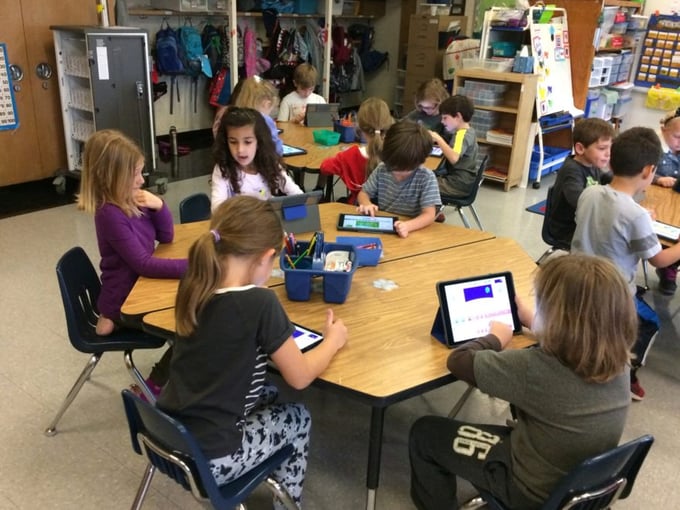Sarah Schemanske is a PLTW Launch Lead Teacher at Wines Elementary in Ann Arbor, Michigan. Sarah teaches PLTW to all students in kindergarten through fifth grade. Sarah has previously taught robotics and created and led a district-wide robotics challenge and an after-school robotics club for 11 years.
Giggles fill the room daily as students work on designing and animating their stories for the Animated Storytelling module. As students program their characters to spin, fly, and move, their excitement and engagement is undeniable. They love learning new features on Scratch Jr. that they can use to enhance their animations and bring their imaginations to life.
I'd like to share eight lessons I've learned from my experience with this module:
1.) The possibilities are endless. Did you know you can create anything as an item using the character function, then selecting the blank piece of paper followed by the paintbrush? Students do not need to be limited on what characters they can choose to be in their stories; in fact, they can personalize characters to match their appearance or imagination. Using the blank sheet and paintbrush, students can create models for any concept they're learning.
2.) Sharing is invaluable. Students explode with pride when given the opportunity to share their stories. Student authors loved having their animated story projected using Reflector and getting to shine in front of their peers. The students also love having their presentations recorded so they can share with loved ones at home. Parents see the power of PLTW and are shocked to see how well young minds can quickly and effectively grasp a foundational understanding of coding.
3.) Students learn to identify and correct mistakes. Students are able to diagnose problems in their code and identify solutions to help the program run as imagined. The students start to become their own best problem solvers and love helping others and sharing cool new tricks and coding strategies they have discovered.
4.) Voice recordings are a favorite. Although voice recordings can lead to silliness, the recordings can also be a powerful tool to allow students to give a voice to their animations or enhance the story elements they've created and animated. Since the voice recordings in my classroom were student-created, the possibilities of what could be included were endless.
5.) Speech bubbles are a great introduction to adding dialogue. Young authors can be overwhelmed with the grammar features of adding dialogue to a writing sample. By using speech bubbles, students are able to enrich their writing with dialogue without having to be concerned about all of the text features of adding dialogue to a traditional writing piece. In the process, students learn how powerful dialogue can be.
6.) The module provides excellent opportunities for students to be creative. As students explore various ways to tell their story, they are allowed to let their thoughts flow freely. When students are challenged to think of how to communicate their ideas non-verbally, they must make sure their thoughts are expressed with details that help to convey meaning. In my classroom, students enjoyed knowing there is no one correct answer and were excited to illustrate the story they created in their minds.
7.) Coding knowledge is not limited to PLTW. Scratch Jr. can be used across all content areas. Students can use Scratch Jr. to retell the narratives in any books they have read or to animate any story they have written. Students can use Scratch Jr. coding to help animate their understanding of many curriculum concepts across core areas. Imagine being able to animate your understanding of math and science concepts and being able to use this tool to support your arguments!
8.) Students learn through exploration and discovery. Students enjoyed having a chance to “free create.” Students in my class were not limited to a certain topic or criteria but were instead encouraged to create using the coding features learned in class. The projects the students created without barriers allowed them to express their personalities and interests. Students have downloaded Scratch Jr. on their personal iPads, which speaks volumes about the validity of teaching students computer science. Students are excited, engaged, and eager to apply and extend their learning experience.
PLTW’s blog is intended to serve as a forum for ideas and perspectives from across our network. The opinions expressed are those of each guest author.


